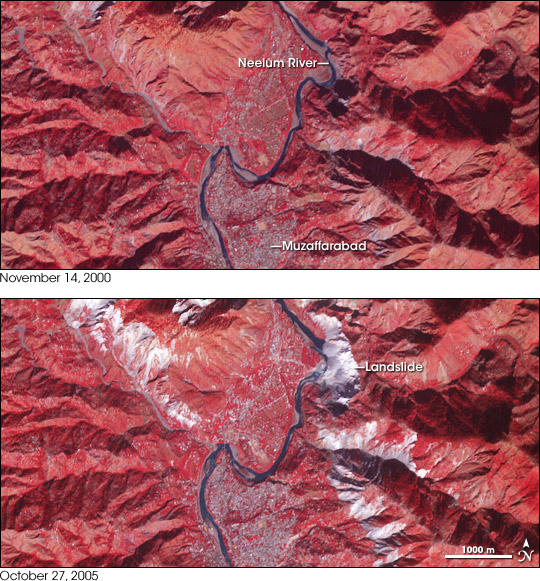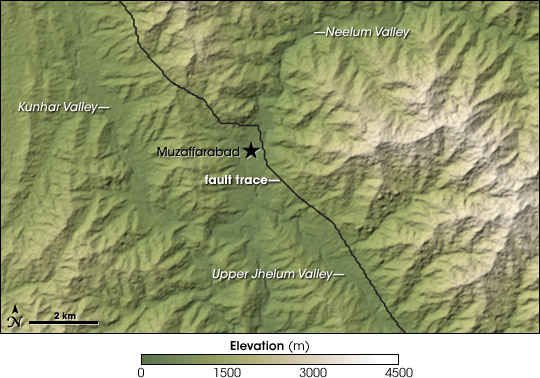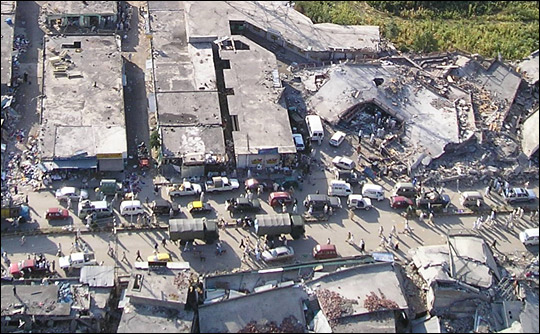

Mapping Deformation |
|||
|
Yeats, an earthquake expert, has a long history of working in Pakistan. After the 2005 Kashmir earthquake, he joined a team of researchers who were the first to map the fault line on the ground. The team returned to the area several times to walk the fault and record the resulting earthquake deformation. “In that kind of terrain, seventy-five kilometers [forty-seven miles] takes a long time to cover,” Yeats said. This traditional method of ground surveying can be difficult after an earthquake because the land surface has changed. Mapping ruptures typically means finding features that used to be continuous before the earthquake, like a road or fence. But in parts of Kashmir, few of these man-made features exist, meaning that the survey team had to find natural features that had been disrupted by the fault, like small crests or river gullies. |
|||
 |
|||
|
Because of the difficulties of ground surveying, researchers like Avouac are investigating how satellite imagery can aid ground surveys and rescue work by generating more immediate maps of earthquake deformation. In theory, observing earthquake deformation should be as simple as comparing two optical satellite images that show the land surface before and after the earthquake. However, correlating three-dimensional images is technically very difficult. Avouac said, “There are distortions in the images because of the topography and geometry of the terrain, the angle at which the satellite instrument is viewing the Earth’s surface, and the satellite’s motion.” When correlating the two images, all of these distortions produced visual offsets in the resulting image that the earthquake did not cause. |
The Neelum River tumbles over rapids created by the earthquake, which lifted the river upstream of the rapids and lowered it on the downstream side. Yeats and his team used changes in natural features like riverbeds to map ground movement during the Kashmir earthquake. Geologists often map faults using post-earthquake breaks in man-made features like roads or fences, but few of those existed in the Kashmir earthquake zone. (Photograph ©2005 Robert Yeats.) |
||
 |
|||
|
Avouac’s team discovered that accurately correlating the images was not a simple process. To remove the distortions, the team needed to match geographic coordinates between the images and the ground; calculate the satellite’s position and motion; drape the images onto the corresponding portion of the Earth’s surface; and then compare differences between the two images. Avouac and his team refined these steps until they created a reliable technique that would accurately show the earthquake deformation without the visual distortions. |
These satellite images show the area surrounding Muzaffarabad before (top) and after (bottom) the 2005 earthquake. The most obvious effect of the quake was a series of landslides, which appear white or light gray. The images are made from near-infrared, red, and green light. Vegetation is red, water is blue, and developed areas are gray. (NASA images by Robert Simmon, based on ASTER data.) |
||
 |
|||
|
The team applied this technique using imagery of the Kashmir area from the Advanced Spaceborne Thermal Emission and Reflection Radiometer (ASTER) aboard the NASA Terra satellite. Although Avouac has a variety of image sources to choose from, he frequently relies on ASTER images from the NASA Land Processes Distributed Active Archive Center (LP DAAC). He said, “I’ve switched to using ASTER because the community of users is much larger and because of the lower cost.” Avouac chose an image taken before the earthquake and compared it to a post-earthquake image captured on October 27, 2005. The results were successful, and correlated very well with the surface rupture measured by Yeats’ team. Avouac said, “We confirmed that our technique can provide information that may be very difficult to measure in the field but is critical for modeling earthquakes.” Remote answers to reliefEarthquake-stricken areas are notoriously difficult for relief workers to access because communication networks and infrastructure are damaged. Avouac hopes that the technique he and his colleagues developed can be used to hasten aid to future earthquake victims. He said, “Our technique provides detailed information that could be used by rescue teams to estimate whether a major town has been badly shaken or not.” Wiley Thompson, a lieutenant colonel in the United States Army serving in Afghanistan at the time of the quake, assisted with the disaster relief efforts. Thompson said, “As a disaster response coordinator, my goal was to get relief—the right kind of relief—to the people who needed it the most at that moment.” |
Avouac’s team compared satellite images from before and after the earthquake to trace the exact location of the fault on the Earth’s surface. The fault line generally angled from the northwest to the southeast, directly through Muzaffarabad. (NASA map by Robert Simmon, based on data from ASTER and COSI-Corr.) |
||
 |
|||
|
Having access to remote sensing and field studies can help relief workers zoom in on a crisis area. Thompson said, “You need to know where to go, so you don’t spend time going to places that weren’t the worst hit. I call it the flash-to-bang. From the first event to the first relief there, you want to minimize the time in between.” Researchers often try to deliver maps and data as soon after an earthquake as possible, but because many relief efforts evolve into long-term projects, new information can be helpful at any stage. New maps, for instance, may reveal damaged towns that were initially missed, but where relief is still badly needed. Thompson said, “Just because you don’t have definitive information right after an earthquake doesn’t mean it’s not going to do you some good later.” Recovering from the October 2005 Kashmir earthquake will likely take several more years, putting Kashmir once again at a crossroads, this time between the old and the new. Governments are razing old concrete block buildings and replacing them with modern structures designed to better withstand earthquakes. Relief organizations are helping relocate residents of towns destroyed by the earthquake to newly erected town sites. And scientists and researchers continue to focus on Kashmir and other earthquake-prone areas, mapping ancient geological faults and identifying new ways to examine an earthquake’s aftermath. Avouac said, “By studying these ruptures, we can learn more about the characteristics of future earthquakes, like what kind of ground motion we can expect.” Understanding how past earthquakes happened and how much damage they caused can help scientists estimate future seismic hazards and pinpoint areas with a high earthquake risk. They hope that this knowledge will eventually protect people living in areas with earthquakes.
About the Remote Sensing Data Used
|
A line of vehicles jams the road through Balakot in the Kashmir earthquake’s aftermath. Satellite data help disaster-relief workers to quickly allocate resources to the worst hit areas and to avoid bottlenecks due to damaged or blocked roads. Researchers can also use satellite data to map potential hazards, enabling people to mitigate potential disasters. (Photograph ©2005 Wiley Thompson.) |
||